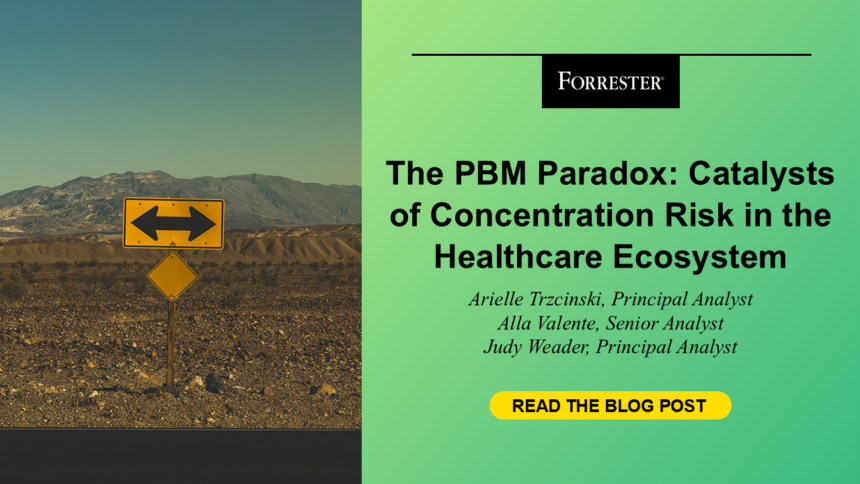This week, Express Scripts filed a lawsuit against the Federal Trade Commission (FTC) demanding retraction of a recent report on the pharmacy benefit manager (PBM) industry. News of this suit is the latest in a string of headlines calling attention to concentration risk in healthcare. The PBM market’s oligopoly isn’t new, but high-profile, widespread events such as the Change Healthcare breach and CrowdStrike disruption give emphasis to the ill effects of concentration risk in the healthcare system.
A recent study by the American Medical Association (AMA) noted that just four firms dominate 70% of the PBM market, a textbook definition of an oligopoly. Furthermore, the HHI (Herfindahl–Hirschman Index), a key indicator used by the US Department of Justice and the FTC, shows that 82% of regional markets are highly concentrated.
Concentration Risk Is Exacerbating Medical Deserts
Healthcare is nearing a perilous inflection point. As concentration risk erodes the healthcare ecosystem’s stability, it accelerates the spread of medical deserts. Significant shortages and barriers in access to essential healthcare affect access to medications, primary-care providers, hospitals, emergency services, community health centers, and more. It’s no wonder, therefore, that the US came in last in a recent report comparing healthcare systems of 10 high-income nations. The level of concentration risk among PBMs raises concerns about medication cost and network access, shining a light on a few high-impact groups:
- Managed Medicaid beneficiaries. Vulnerable populations face the biggest threat, with a few PBMs dominating the managed Medicaid business. As a result, this vulnerable population risks unknowingly overpaying for medications when they go to a nearby but nonpreferred pharmacy. Medications that ring in at a higher cost risk setting off a decline in medication adherence and thus worse population health outcomes.
- Seniors using Medicare Part D. The largest chunk of Optum’s business is in Medicare Part D, where it controls 27.7% of the market. CVS again holds the largest chunk: 33.4% of the Medicare market. This high concentration gives PBMs substantial bargaining power with drug manufacturers, which can influence drug prices and availability for Medicare beneficiaries. In 2023, the US government spent about $111 billion on Medicare Part D. The Inflation Reduction Act allows Medicare to negotiate lower prices for high-cost medications, which is impactful but benefits only a small percentage of the population. For most, out-of-pocket costs are expected to increase. Insurers report that they plan to exclude more medicines from Part D plans and are expected to ramp up use of prior authorizations and step therapy requirements. Formularies already exclude nearly half of brand medicines.
- Pharmacies across key geographies. Smaller, independent pharmacies struggle to compete. Reduced negotiating power leads to closures and reduced access for patients. While these closures do occur in rural or underserved areas, urban areas are not immune: Already, up to one-third of Chicagoans live in a pharmacy desert, and low-income urban communities nationwide have a higher risk of seeing store closures. The impact of these losses extends well beyond medication access, as retail pharmacies play a key role in delivering routine care and vaccinations.
From Vulnerable To Vigilant: Diluting The Concentration Risk
AMA President Bruce Scott, MD, said that the findings “warrant attention as Congress and the administration continue their work to protect patients and ensure prescription drugs remain affordable and accessible.” Looming regulation and a potential ruling by the Supreme Court also cast a long shadow on the future of the PBM market, but regulations are exceptionally unlikely to eliminate concentration risk entirely.
In the meantime, health insurers and PBMs must prepare now for greater government oversight and scrutiny on future business tie-ups. All stakeholders — particularly health insurers and employers that sponsor health insurance — must recognize the potential harm that concentration risk creates, including to their own brand, and consider using a multitude of players. It is critical that all healthcare ecosystem stakeholders implement key steps to tackle concentration risk and combat medical deserts immediately.
Check out the latest research on medical deserts and the steps that you can take now to mitigate their spread. For more information, see our recent blog about concentration risk, and stay tuned for additional research on the topic.
Schedule time now to discuss how we can protect future access to high-quality healthcare for all populations.








